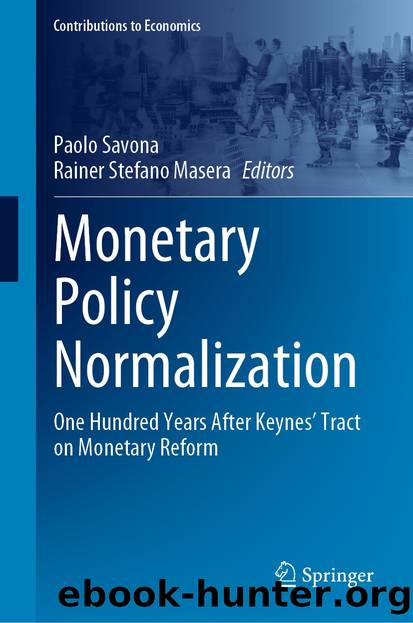Monetary Policy Normalization by Unknown

Author:Unknown
Language: eng
Format: epub
ISBN: 9783031387081
Publisher: Springer Nature Switzerland
2 Complex Systems for Finance
âEverything affects everything else, and you have to understand that whole web of connections.â (Waldrop, 1992).
In the 1970s, there were a number of major changes in the financial sector that caused the creation of new multidisciplinary approaches to market analysis and forecasting. Just think of the New York Stock Exchange, which required financial intermediaries to have a very high trading fee in order to trade in its market. The American state took a very firm stance, and Congress eliminated the tax altogether, allowing a democratisation of investment so that all citizens could access savings management services. The creation of the NASDAQ, the worldâs first electronic stock market, in 1971, allowed for a technologically advanced stock listing system, giving investors the ability to communicate their orders to brokers in a fully automatic way. The most significant evolution, however, has been seen at the technological level, with the beginning of the era of electronic trading and the creation of the first IT infrastructures used to place orders for financial products among investors. The accumulation of a large amount of data at a pace even faster than a second needed huge monetary investments by traditional financial institutions such as banks, requiring new paradigms to be able to describe and, above all, predict financial markets.
In times of great intellectual crisis and the collapse of old paradigms, therefore, new ways are needed to be able to explain the world. Restricting our focus to financial markets, in the 1980s the Theory of Complex Systems emerged, an approach of multidisciplinary physics intent on studying those systems in which the interactions between the individual components cause changes in the overall structure of the phenomenon (Ladyman & Wiesner, 2020). Some examples of complex systems would be the evolution over time of smoke coils emanating from a cigarette or chimney, the remodelling of live or dead cells within human epithelial tissue, the electrocardiogramâs waves in the case of atrial fibrillation, and the performance of financial markets. All these phenomena, despite being different from each other, can be explained by physical laws relating to the same branch, namely, statistical mechanics. This branch, which we will talk in depth about later, helps to describe the thermal phenomena, which are therefore macroscopic, and the microscopic ones of atoms and molecules, offering a rigorous mathematical way to represent systems with a large number of particles. In this type of phenomenon, whose behaviour is hardly predictable with traditional methods, evolution is often governed by deterministic chaos.
What is Chaos?
We often hear this word in our day-to-day lives, with the meanings of âuncertaintyâ and âdisorder.â In physics, however, chaos helps to explain the multitude of phenomena that happen before our eyes. The behaviour of a crowd of people at a concert, the dynamics of particles within a cloud, the decisions made by a group of investors after the bursting of a financial bubble. These are all examples of chaotic systems in which a tiny initial variation, if multiplied by millions of times, gives rise to completely different results.
Download
This site does not store any files on its server. We only index and link to content provided by other sites. Please contact the content providers to delete copyright contents if any and email us, we'll remove relevant links or contents immediately.
| Analysis & Strategy | Bonds |
| Commodities | Derivatives |
| Futures | Introduction |
| Mutual Funds | Online Trading |
| Options | Portfolio Management |
| Real Estate | Stocks |
Rich Dad Poor Dad by Robert T. Kiyosaki(6519)
Pioneering Portfolio Management by David F. Swensen(6261)
How To Win Friends and Influence People by Dale Carnegie(4475)
The Money Culture by Michael Lewis(4141)
The Dhandho Investor by Mohnish Pabrai(3729)
The Wisdom of Finance by Mihir Desai(3699)
Liar's Poker by Michael Lewis(3416)
Fooled by Randomness: The Hidden Role of Chance in Life and in the Markets by Nassim Nicholas Taleb(3083)
The ONE Thing by Gary Keller(3036)
Mastering Bitcoin: Programming the Open Blockchain by Andreas M. Antonopoulos(3015)
The Intelligent Investor by Benjamin Graham Jason Zweig(3014)
Rich Dad Poor Dad: What The Rich Teach Their Kids About Money - That The Poor And Middle Class Do Not! by Robert T. Kiyosaki(2930)
How to Day Trade for a Living: Tools, Tactics, Money Management, Discipline and Trading Psychology by Andrew Aziz(2925)
Investing For Dummies by Eric Tyson(2923)
How to Win Friends and Influence People by Dale Carnegie(2885)
The Psychology of Money by Morgan Housel(2817)
Market Wizards by Jack D. Schwager(2674)
Zero Hour by Harry S. Dent Jr. & Andrew Pancholi(2632)
How to Pay Zero Taxes, 2018 by Jeff A. Schnepper(2623)
